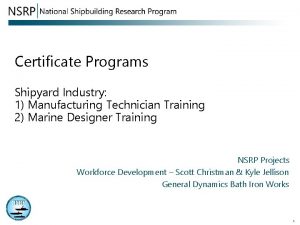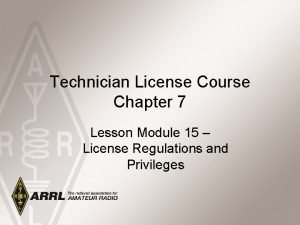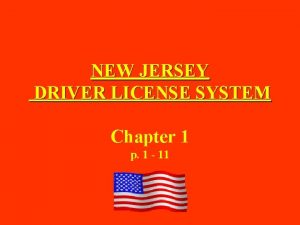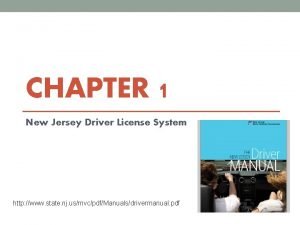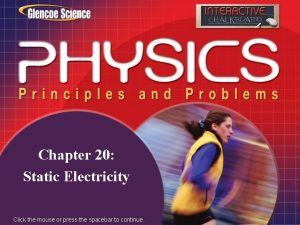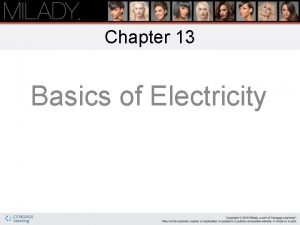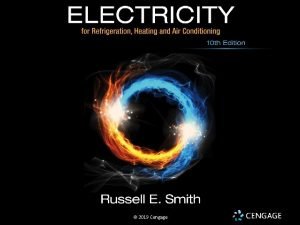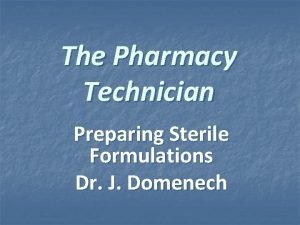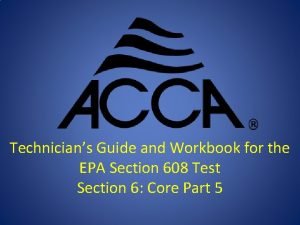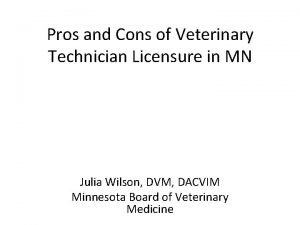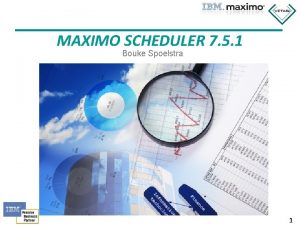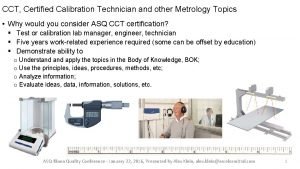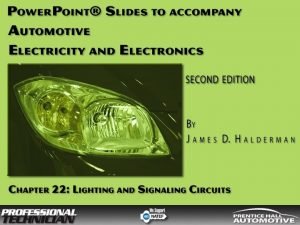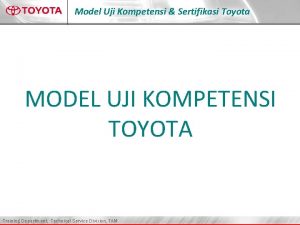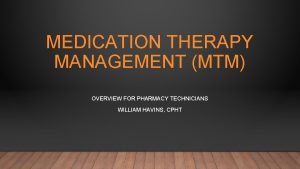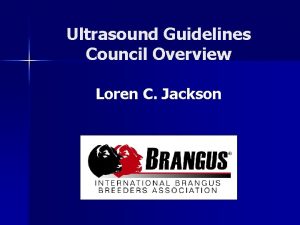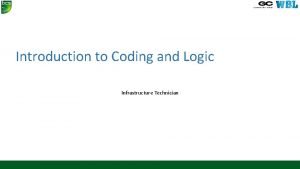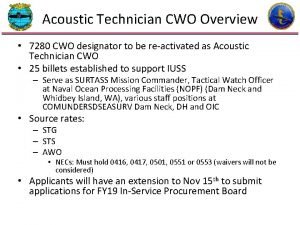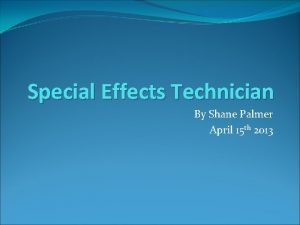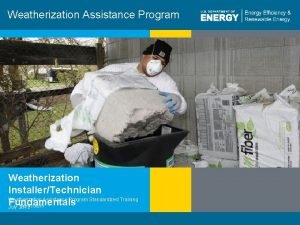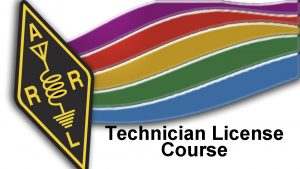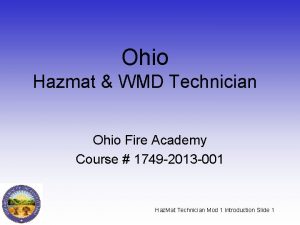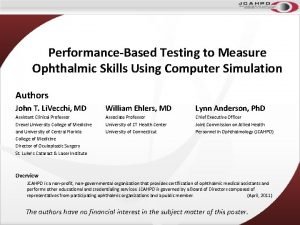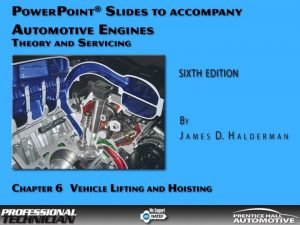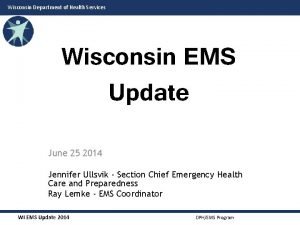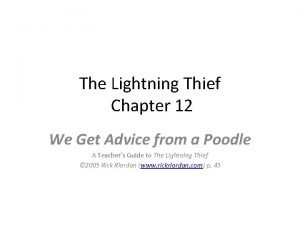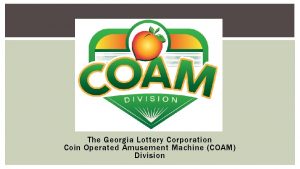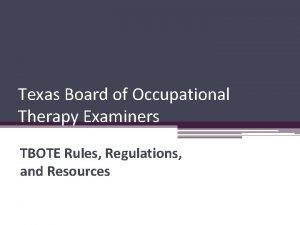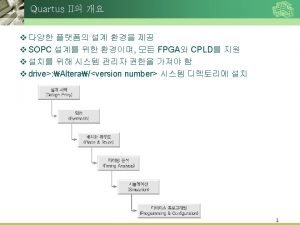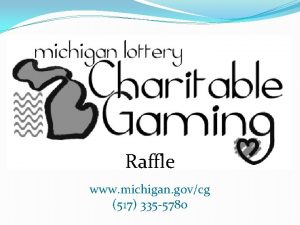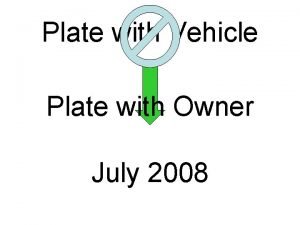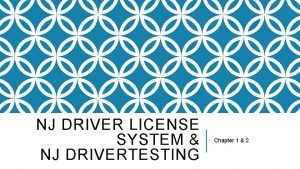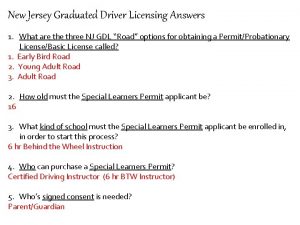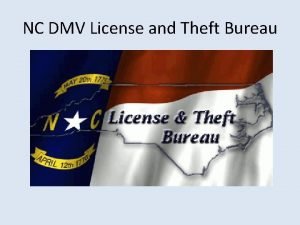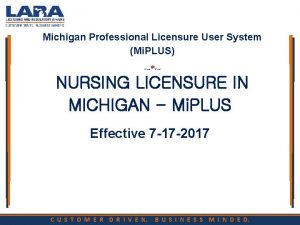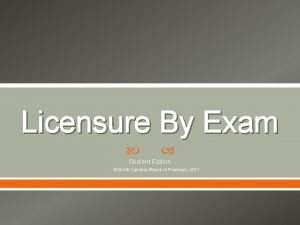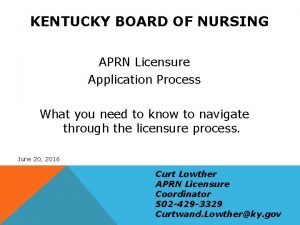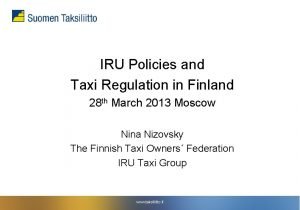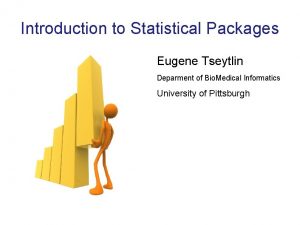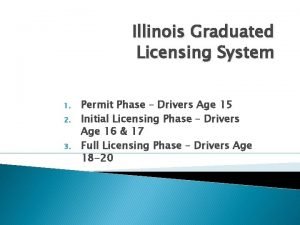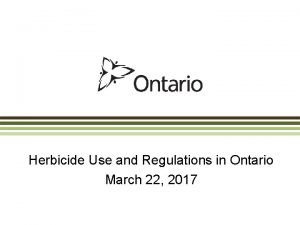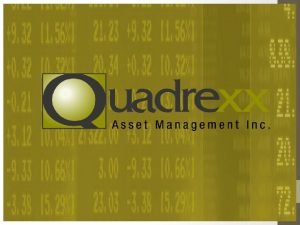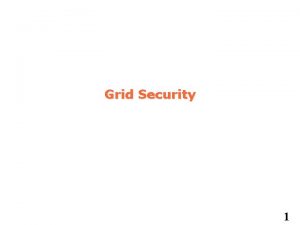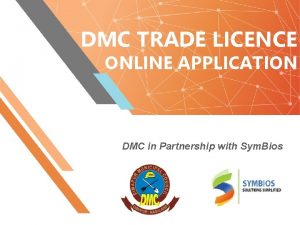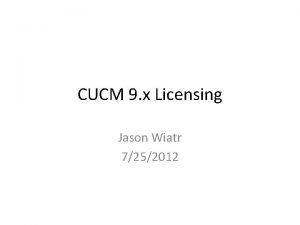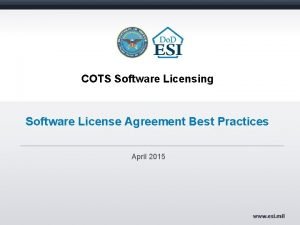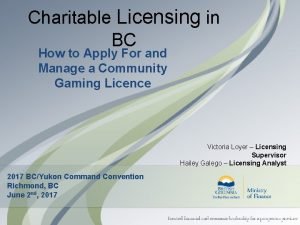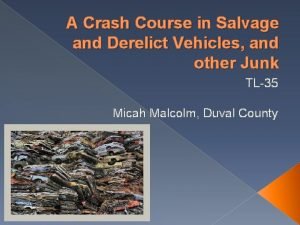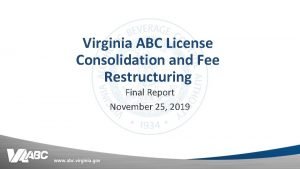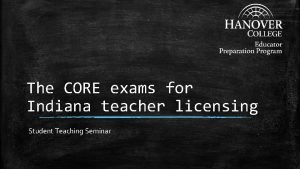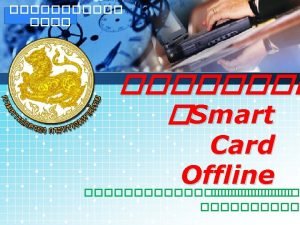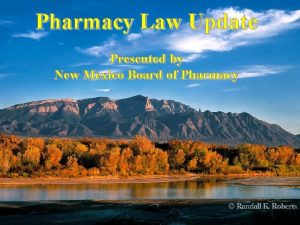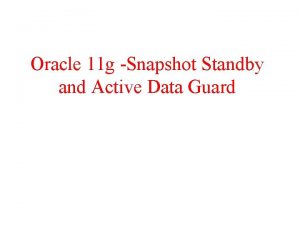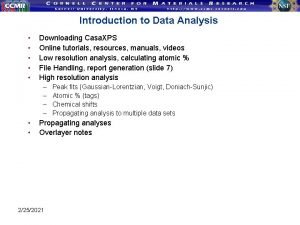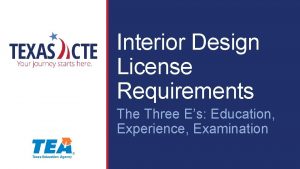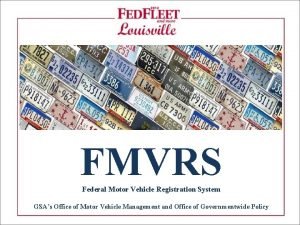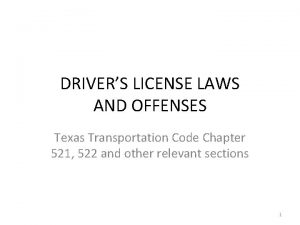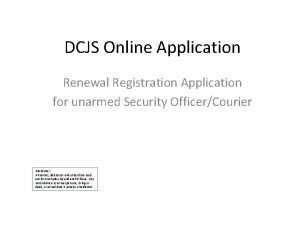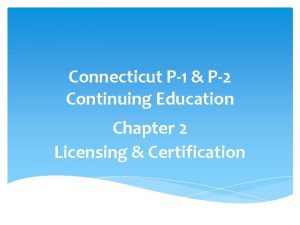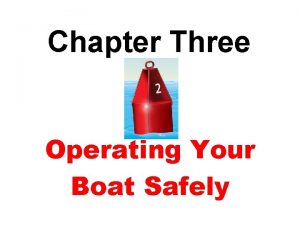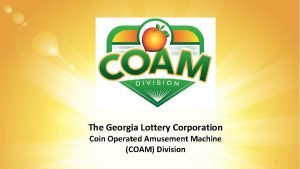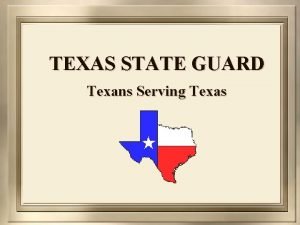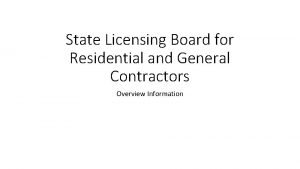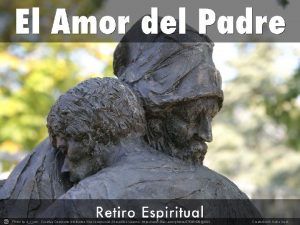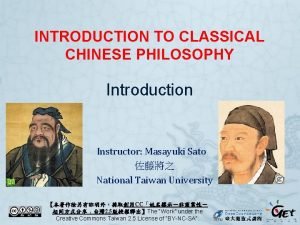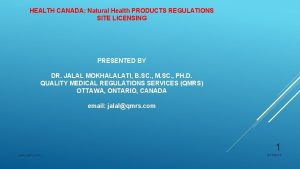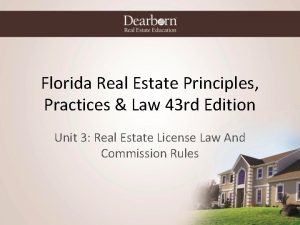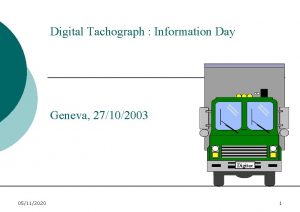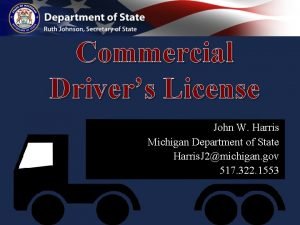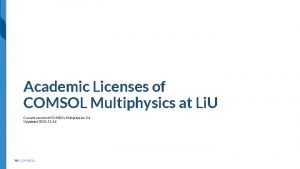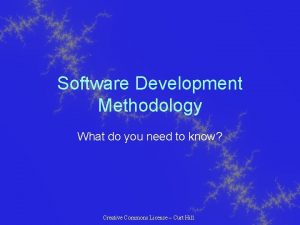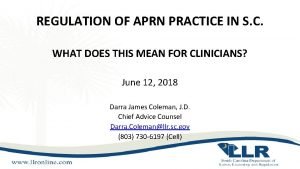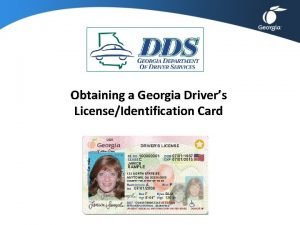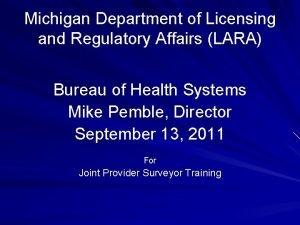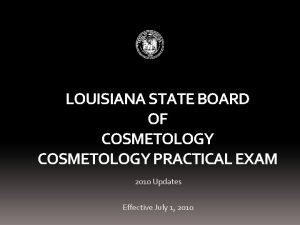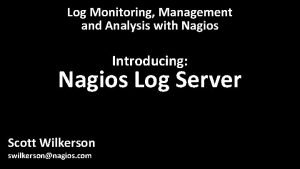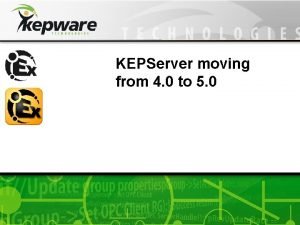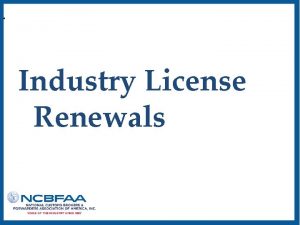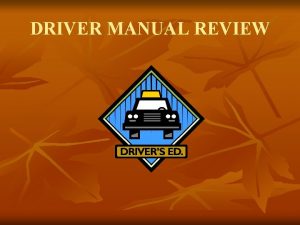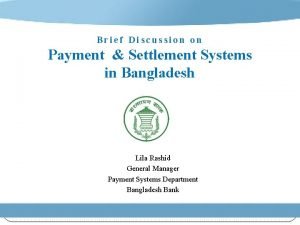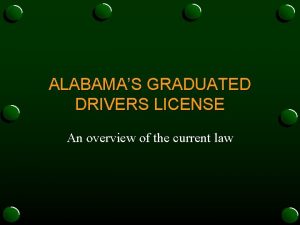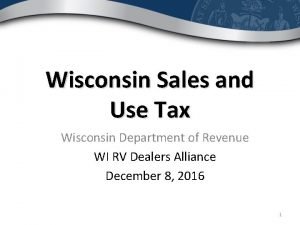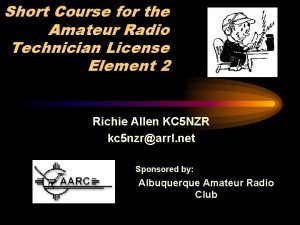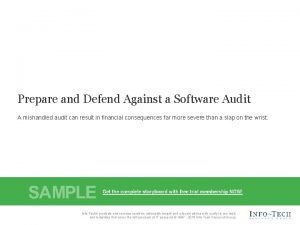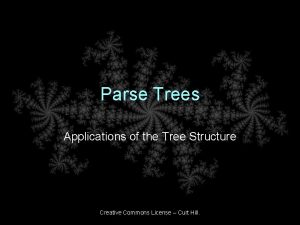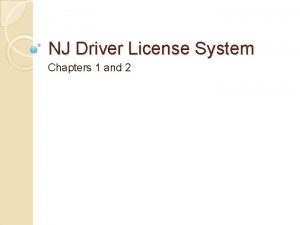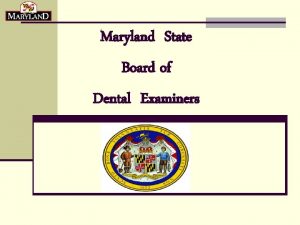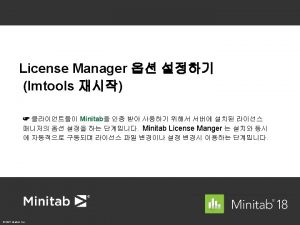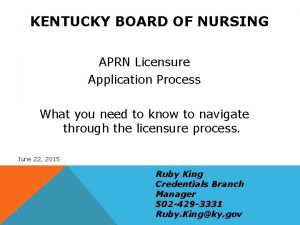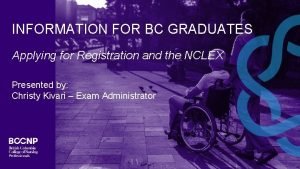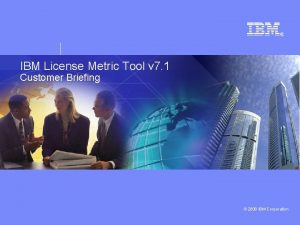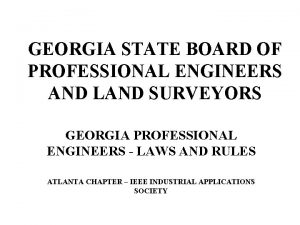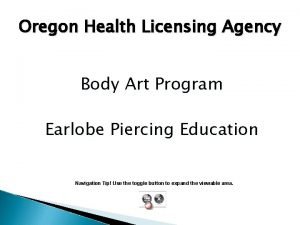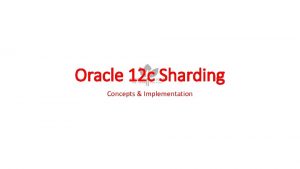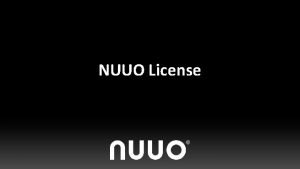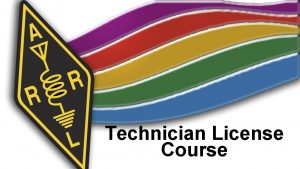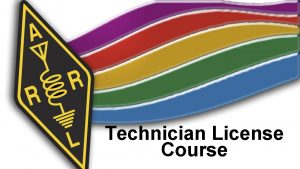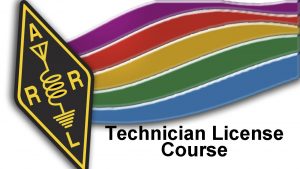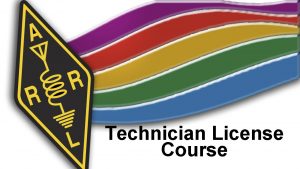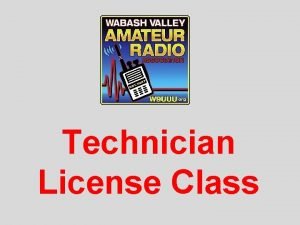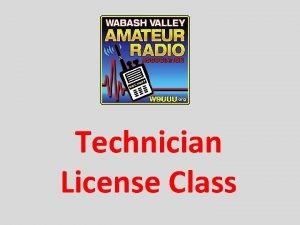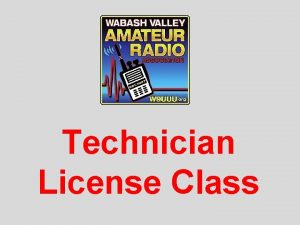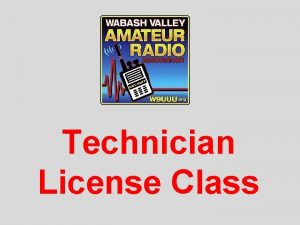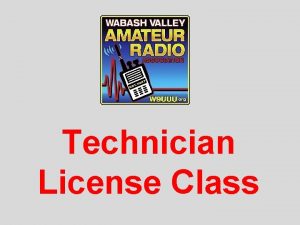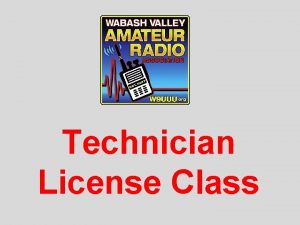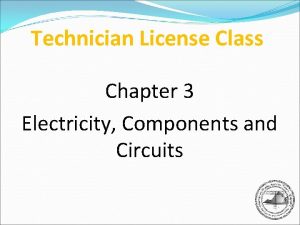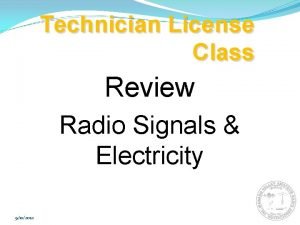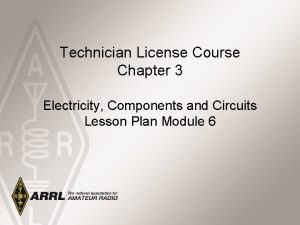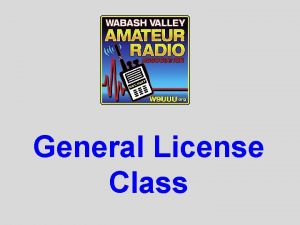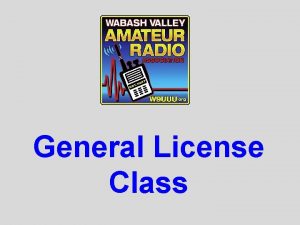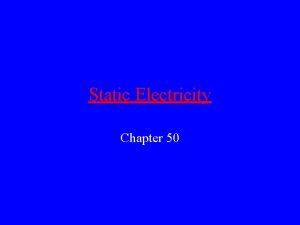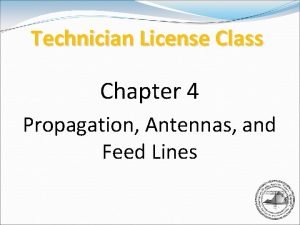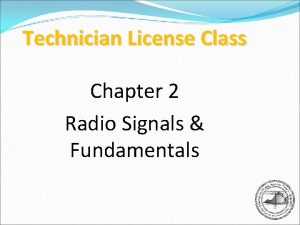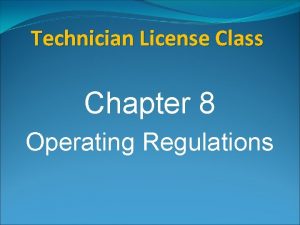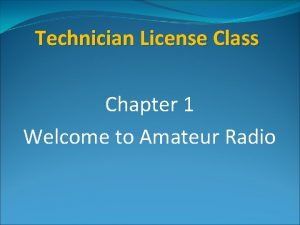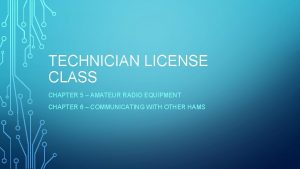Technician License Class Technician Class Chapter 3 Electricity









































































































































































- Slides: 169

Technician License Class

Technician Class Chapter 3 Electricity, Components and Circuits

Electricity Current and Voltage. • Electrons are negatively-charged atomic particles. • Electric current is the flow of electrons through a material.

Electricity Current and Voltage. • The magnitude of a current is the number of electrons flowing past a given point in one second. • Measured in amperes. • 1 Ampere = 1 coulomb/second. • 1 coulomb ≈ 6. 24 billion (6. 24 x 1018) electrons. • Abbreviated to ”Amp” or “A”. • Use symbol “I” in formulas. • Current is measured using an ammeter.

Electricity Current and Voltage. • Voltage is the electrical force that causes electrons to flow. • a. k. a. – Electromotive force (EMF) or potential. • Measured in volts. • Abbreviated to “V” • Use symbol “E” in formulas • Voltage is measured using a voltmeter.

Electricity Current and Voltage. • Voltage has polarity. • Positive voltage attracts electrons. • Negative voltage repels electrons. • Voltage is always referenced between 2 points. • Surface of the earth is often used as a universal reference point. • Called earth ground, ground potential, or ground.

Electricity Current and Voltage. • Direct and alternating current. • A current where the electrons always flow in the same direction is called a direct current (DC). • A current where the direction the electrons are flowing reverses is called an alternating current (AC). • A voltage that always has the same polarity is called a direct voltage (VDC). • A voltage where the polarity changes is called an alternating voltage (VAC).

T 5 A 01 -- Electrical current is measured in which of the following units? A. B. C. D. Volts Watts Ohms Amperes

T 5 A 03 -- What is the name for the flow of electrons in an electric circuit? A. B. C. D. Voltage Resistance Capacitance Current

T 5 A 04 -- What is the name for a current that flows only in one direction? A. B. C. D. Alternating current Direct current Normal current Smooth current

T 5 A 05 -- What is the electrical term for the electromotive force (EMF) that causes electron flow? A. B. C. D. Voltage Ampere-hours Capacitance Inductance

T 5 A 09 -- What is the name for a current that reverses direction on a regular basis? A. B. C. D. Alternating current Direct current Circular current Vertical current

T 5 A 11 -- What is the unit of electromotive force? A. B. C. D. The volt The watt The ampere The ohm

T 7 D 01 -- Which instrument would you use to measure electric potential or electromotive force? A. B. C. D. An ammeter A voltmeter A wavemeter An ohmmeter

T 7 D 04 -- Which instrument is used to measure electric current? A. B. C. D. An ohmmeter A wavemeter A voltmeter An ammeter

Electricity Circuits. • A circuit is any path where current can flow. • For current to flow, the circuit must be closed. • Current eventually ends up back where it started. • If only one path, it is a series circuit. • Same current flows through all components. • If multiple paths, it is a parallel circuit. • Same voltage is across all components.

Electricity Circuits. • Electrical pressure and flow. • The flow of water through a hose is a good analogy to understand the characteristics of electricity and how they are related.

Electricity Circuits. • Series circuit. • The voltage across each component varies depending on the type and value of each component. • The sum of all voltages around the circuit is zero. • The same current flows through all components.

Electricity Circuits. • Parallel circuit. • The voltage across each component is the same. • The sum of all currents in each component equals the total current. • The current at the junction of 2 components varies depending on the type and value of each component.

Electricity Circuits. • Measuring voltage and current. • Voltmeters are always placed in parallel with the circuit. • Ammeters are always placed in series with the circuit.

T 5 A 13 -- In which type of circuit is current the same through all components? A. B. C. D. Series Parallel Resonant Branch

T 5 A 14 -- In which type of circuit is voltage the same across all components? A. B. C. D. Series Parallel Resonant Branch

T 5 D 13 -- What happens to current at the junction of two components in series? A. It divides equally between them B. It is unchanged C. It divides based on the value of the components D. The current in the second component is zero

T 5 D 14 -- What happens to current at the junction of two components in parallel? A. It divides between them dependent on the value of the components B. It is the same in both components C. Its value doubles D. Its value is halved

T 5 D 15 -- What is the voltage across each of two components in series with a voltage source? A. The same voltage as the source B. Half the source voltage C. It is determined by the type and value of the components D. Twice the source voltage

T 5 D 16 -- What is the voltage across each of two components in parallel with a voltage source? A. It is determined by the type and value of the components B. Half the source voltage C. Twice the source voltage D. The same voltage as the source

T 7 D 02 -- What is the correct way to connect a voltmeter to a circuit? A. B. C. D. In series with the circuit In parallel with the circuit In quadrature with the circuit In phase with the circuit

T 7 D 03 -- How is a simple ammeter connected to a circuit? A. B. C. D. In series with the circuit In parallel with the circuit In quadrature with the circuit In phase with the circuit

Electricity The Multimeter. • The most basic piece of test equipment. • Everybody should have one. • Three (or more) instruments in one: • Voltmeter • Ammeter • Ohmmeter • Measures volts, amperes, and ohms in one package.

Electricity The Multimeter. • Digital multimeter (DVM) • Very inexpensive. • Often has extra features in addition to measuring volts, amps, & ohms.

Electricity The Multimeter. • Meters can only measure current. • A voltmeter measures voltage by: • Placing a known resistance in parallel with the voltage being measured. • Measuring the current through the known resistance. • Calculating the voltage using Ohm’s law. • An ohmmeter measures resistance by: • Applying a known voltage to the circuit being measured. • Measuring the resulting current. • Calculating the resistance using Ohm’s law.

Electricity The Multimeter. • Measuring resistance. • NEVER attempt to measure resistance with power applied to the circuit. • You WILL damage your multimeter. • NEVER attempt to measure voltage with the resistance setting. • You WILL damage your multimeter.

Electricity The Multimeter. • When measuring high voltages, make certain that the voltmeter and the test leads are rated for the voltage being measured. • If a resistance reading is initially very low but slowly increases to a higher value, it indicates the presence of a large capacitance in the circuit.

T 7 D 06 -- Which of the following might damage a multimeter? A. Measuring a voltage too small for the chosen scale B. Leaving the meter in the milliamps position overnight C. Attempting to measure voltage when using the resistance setting D. Not allowing it to warm up properly

T 7 D 07 -- Which of the following measurements are commonly made using a multimeter? A. B. C. D. SWR and RF power Signal strength and noise Impedance and reactance Voltage and resistance

T 7 D 10 -- What is probably happening when an ohmmeter, connected across an unpowered circuit, initially indicates a low resistance and then shows increasing resistance with time? A. B. C. D. The ohmmeter is defective The circuit contains a large capacitor The circuit contains a large inductor The circuit is a relaxation oscillator

T 7 D 11 -- Which of the following precautions should be taken when measuring circuit resistance with an ohmmeter? A. B. C. D. Ensure that the applied voltages are correct Ensure that the circuit is not powered Ensure that the circuit is grounded Ensure that the circuit is operating at the correct frequency

T 7 D 12 -- Which of the following precautions should be taken when measuring high voltages with a voltmeter? A. Ensure that the voltmeter has very low impedance B. Ensure that the voltmeter and leads are rated for use at the voltages to be measured C. Ensure that the circuit is grounded through the voltmeter D. Ensure that the voltmeter is set to the correct frequency

Electricity Resistance and Ohm’s Law. • Resistance • The opposition to the flow of electrons. • All materials exhibit resistance. • Materials with low resistance are called conductors. • Materials with high resistance are called insulators. • Unit of measurement is the Ohm (Ω). • Measured with an ohmmeter.

T 5 A 07 -- Which of the following is a good electrical conductor? A. B. C. D. Glass Wood Copper Rubber

T 5 A 08 -- Which of the following is a good electrical insulator? A. B. C. D. Copper Glass Aluminum Mercury

T 7 D 05 -- What instrument is used to measure resistance? A. B. C. D. An oscilloscope A spectrum analyzer A noise bridge An ohmmeter

Electricity Resistance and Ohm’s Law. • First published in 1827 by Georg Ohm in his book “Die galvanische Kette, mathematisch bearbeitet ” • Mathematically describes the relationship between voltage, current, and resistance. • Most basic formula in electricity and electronics.

Electricity Resistance and Ohm’s Law. • E = Electromotive Force • Force causing electrons to flow. • I = Current Intensity • Number of electrons flowing past a point in a given period of time. • R = Resistance • Opposition to flow of electrons. E=Ix. R I = E/R R = E/I

T 5 D 01 -- What formula is used to calculate current in a circuit? A. Current (I) equals voltage (E) multiplied by resistance (R) B. Current (I) equals voltage (E) divided by resistance (R) C. Current (I) equals voltage (E) added to resistance (R) D. Current (I) equals voltage (E) minus resistance (R)

T 5 D 02 -- What formula is used to calculate voltage in a circuit? A. Voltage (E) equals current (I) multiplied by resistance (R) B. Voltage (E) equals current (I) divided by resistance (R) C. Voltage (E) equals current (I) added to resistance (R) D. Voltage (E) equals current (I) minus resistance (R)

T 5 D 03 -- What formula is used to calculate resistance in a circuit? A. Resistance (R) equals voltage (E) multiplied by current (I) B. Resistance (R) equals voltage (E) divided by current (I) C. Resistance (R) equals voltage (E) added to current (I) D. Resistance (R) equals voltage (E) minus current (I)

T 5 D 04 -- What is the resistance of a circuit in which a current of 3 amperes flows through a resistor connected to 90 volts? A. B. C. D. 3 ohms 30 ohms 93 ohms 270 ohms

T 5 D 05 -- What is the resistance in a circuit for which the applied voltage is 12 volts and the current flow is 1. 5 amperes? A. B. C. D. 18 ohms 0. 125 ohms 8 ohms 13. 5 ohms

T 5 D 06 -- What is the resistance of a circuit that draws 4 amperes from a 12 -volt source? A. B. C. D. 3 ohms 16 ohms 48 ohms

T 5 D 07 -- What is the current in a circuit with an applied voltage of 120 volts and a resistance of 80 ohms? A. B. C. D. 9600 amperes 200 amperes 0. 667 amperes 1. 5 amperes

T 5 D 08 -- What is the current through a 100 ohm resistor connected across 200 volts? A. B. C. D. 20, 000 amperes 0. 5 amperes 2 amperes 100 amperes

T 5 D 09 -- What is the current through a 24 -ohm resistor connected across 240 volts? A. B. C. D. 24, 000 amperes 0. 1 amperes 10 amperes 216 amperes

T 5 D 10 -- What is the voltage across a 2 -ohm resistor if a current of 0. 5 amperes flows through it? A. B. C. D. 1 volt 0. 25 volts 2. 5 volts 1. 5 volts

T 5 D 11 -- What is the voltage across a 10 -ohm resistor if a current of 1 ampere flows through it? A. B. C. D. 1 volt 10 volts 11 volts 9 volts

T 5 D 12 -- What is the voltage across a 10 -ohm resistor if a current of 2 amperes flows through it? A. B. C. D. 8 volts 0. 2 volts 12 volts 20 volts

Electricity Power. • The rate at which energy is consumed. • Measured in watts. • Abbreviated “W”. • Use symbol “P” in formulas. • 1 hp ≈ 745 watts. • Power is measured using a wattmeter.

Electricity Power. P Watts E Volts I Amps P=Ex. I E=P/I I=P/E P = E 2/R P = I 2 x R

T 5 A 02 -- Electrical power is measured in which of the following units? A. B. C. D. Volts Watts Ohms Amperes

T 5 A 10 -- Which term describes the rate at which electrical energy is used? A. B. C. D. Resistance Current Power Voltage

T 5 C 08 -- What is the formula used to calculate electrical power in a DC circuit? A. B. C. D. Power (P) equals voltage (E) multiplied by current (I) Power (P) equals voltage (E) divided by current (I) Power (P) equals voltage (E) minus current (I) Power (P) equals voltage (E) plus current (I)

T 5 C 09 -- How much power is being used in a circuit when the applied voltage is 13. 8 volts DC and the current is 10 amperes? A. B. C. D. 138 watts 0. 7 watts 23. 8 watts

T 5 C 10 -- How much power is being used in a circuit when the applied voltage is 12 volts DC and the current is 2. 5 amperes? A. B. C. D. 4. 8 watts 30 watts 14. 5 watts 0. 208 watts

T 5 C 11 -- How many amperes are flowing in a circuit when the applied voltage is 12 volts DC and the load is 120 watts? A. B. C. D. 0. 1 amperes 10 amperes 12 amperes 132 amperes

Components and Units Basic Components. • 3 basic types of components: • Resistors. • Capacitors. • Inductors.

Components and Units Basic Components. • Resistors. • A specific amount of a partially conductive material. • Oppose flow of electric current. • Resistance. • Convert electrical energy to heat energy.

Components and Units Basic Components. • Resistors. • Unit of measurement is the ohm (Ω). • Values expressed as: • Ohms (Ω). • Kilohms (1 kΩ = 1, 000 Ω). • Megohms (1 MΩ = 1, 000 Ω). • Values available from <1 Ω to >10 MΩ. • Maximum power rating in watts (W). • 1/8 W to several hundred watts.

Components and Units Basic Components. • Capacitors. • Two conductive surfaces separated by an insulator. • Temporarily store electrical energy. • Stores energy in an electric field. • Capacitance. • Like a very temporary storage battery.

Components and Units Basic Components. • Capacitors. • Unit of measurement is the farad (F). • Values expressed as: • • • § Farads (F). Microfards (1 μF = 10 -6 F). Picofarads (1 p. F = 10 -12 F). Values available from 1 p. F to >1 F. § Maximum voltage rating in volts (V), or kilovolts (k. V). § Values from a few volts to several kilovolts.

Components and Units Basic Components. • Inductors. • A coil of wire, possible wound on a magnetic core. • Temporarily store electrical energy. • Stores energy in a magnetic field.

Components and Units Basic Components. • Inductors. • Unit of measurement is the henry (H). • Values expressed as: • • • § Henries (H). Millihenries (1 m. H = 10 -3 H). Microhenries (1 μH = 10 -6 F). Values available from 1 μH to several Henries. § Maximum rating in milliamps (m. A) or amps (A). § Values from a few milliamps to several amps.

Components and Units Basic Components. • All 3 types of components can be made adjustable. • Commonly referred to as “variable”. • A variable resistor with 3 terminals is often called a “potentiometer”. • Commonly shortened to “pot”. • Used to adjust voltage or signal level. • e. g. – Volume control.

Components and Units Basic Components. • Transformers. • Two or more inductors arranged so that they share their stored magnetic energy. • Used to change AC voltage levels. • e. g. - Change 120 VAC household voltage to a lower value for use in electronic equipment.

Components and Units Color Code.

T 5 C 01 -- What is the ability to store energy in an electric field called? A. B. C. D. Inductance Resistance Tolerance Capacitance

T 5 C 02 -- What is the basic unit of capacitance? A. B. C. D. The farad The ohm The volt The henry

T 5 C 03 -- What is the ability to store energy in a magnetic field called? A. B. C. D. Admittance Capacitance Resistance Inductance

T 5 C 04 -- What is the basic unit of inductance? A. B. C. D. The coulomb The farad The henry The ohm

T 6 A 01 -- What electrical component opposes the flow of current in a DC circuit? A. B. C. D. Inductor Resistor Voltmeter Transformer

T 6 A 02 -- What type of component is often used as an adjustable volume control? A. B. C. D. Fixed resistor Power resistor Potentiometer Transformer

T 6 A 03 -- What electrical parameter is controlled by a potentiometer? A. B. C. D. Inductance Resistance Capacitance Field strength

T 6 A 04 -- What electrical component stores energy in an electric field? A. B. C. D. Resistor Capacitor Inductor Diode

T 6 A 05 -- What type of electrical component consists of two or more conductive surfaces separated by an insulator? A. B. C. D. Resistor Potentiometer Oscillator Capacitor

T 6 A 06 -- What electrical component stores energy in an magnetic field? A. B. C. D. Resistor Capacitor Inductor Diode

T 6 A 07 -- What electrical component usually is constructed as a coil of wire? A. B. C. D. Switch Capacitor Diode Inductor

T 6 D 06 -- What component is commonly used to change 120 V AC house current to a lower AC voltage for other uses? A. B. C. D. Variable capacitor Transformer Transistor Diode

Components and Units Reactance and Impedance. • In circuits containing only resistors, the voltage & current are always “in phase”. • Current flow changes at the same time and in the same direction as the voltage change.

Components and Units Reactance and Impedance. • In circuits containing capacitors or inductors, voltage & current are “out of phase”. • Current flow changes before the voltage changes in a capacitor. • Current “leads” voltage. • Current flow changes after the voltage changes in an inductor. • Current “lags” voltage.

Components and Units Reactance and Impedance. ELI the ICE man

Components and Units Reactance and Impedance. • Opposition to AC current flow in capacitors or inductors is called reactance (X). • Reactance (X) is measured in Ohms (Ω). • Capacitive reactance (XC) is measured in Ohms (Ω). • Inductive reactance (XL) is measured in Ohms (Ω). • Combination of resistance and reactance is called impedance (Z). • Impedance (Z) is measured in Ohms (Ω).

T 5 C 12 -- What is impedance? A. A measure of the opposition to AC current flow in a circuit B. The inverse of resistance C. The Q or Quality Factor of a component D. The power handling capability of a component

T 5 C 13 -- What is a unit of impedance? A. B. C. D. Volts Amperes Coulombs Ohms

Components and Units Resonance. • Because current leads voltage in a capacitor & lags voltage in an inductor, a combination of capacitance & inductance exists where the lead time & lag time cancel, resulting in the current & voltage being in phase. • This condition is called resonance.

Components and Units Resonance. • Resonant circuit. • a. k. a. - Tuned circuit. • Acts as filter. • Used to adjust frequency of receiver or transmitter. • The capacitive reactance (XC) and inductive reactance (XL) in a resonant circuit are equal. • Impedance (Z) of a resonant circuit is purely resistive. • Reactance = 0Ω.

T 6 D 08 -- Which of the following is combined with an inductor to make a tuned circuit? A. B. C. D. Resistor Zener diode Potentiometer Capacitor

T 6 D 11 -- Which of the following is a resonant or tuned circuit? A. An inductor and a capacitor connected in series or parallel to form a filter B. A type of voltage regulator C. A resistor circuit used for reducing standing wave ratio D. A circuit designed to provide high-fidelity audio

Break

Components and Units Diodes, Transistors, and Integrated Circuits. • Resistors, capacitors, and inductors are linear devices. • Response is ALWAYS proportional to the stimulus.

Components and Units Diodes, Transistors, and Integrated Circuits. • Diodes and transistors are non-linear devices. • Response is NOT always proportional to the stimulus.

Components and Units Diodes, Transistors, and Integrated Circuits. • Semi-conductors. • Some materials are not good conductors, but are not good insulators either. • Silicon, Germanium, etc.

Components and Units Diodes, Transistors, and Integrated Circuits. • Doping. • Adding impurities to certain semi-conductor materials changes their ability to control the flow of current. • P-type material. • N-type material.

Components and Units Diodes, Transistors, and Integrated Circuits. • Junctions. • When P-type & N-type materials are placed in contact with each other, a “junction” is created. • Current will flow easily in one direction through a junction but not in the other direction.

Components and Units Diodes, Transistors, and Integrated Circuits. • Diodes. • The function of the diode is to allow the flow of current in only one direction. • Connections named anode & cathode. • Cathode is normally identified with a stripe. • An analogy is a check valve in a water pipe.

Components and Units Diodes, Transistors, and Integrated Circuits. • Diodes.

Components and Units Diodes, Transistors, and Integrated Circuits. • Diodes. • High voltage and/or high current diodes designed for use in power supplies are sometimes called “rectifiers”. • Convert AC voltage to a varying DC voltage.

Components and Units Diodes, Transistors, and Integrated Circuits. • Diodes.

Components and Units Diodes, Transistors, and Integrated Circuits. • Light-Emitting Diodes (LEDs). • Special types of diodes that emit light from the junction when current flows. • Color of the light determined by the type of semi-conductor material used. • Commonly used as visual indicators.

Components and Units Diodes, Transistors, and Integrated Circuits. • Transistors. • Have 3 layers of material & 2 junctions. • N-P-N. • P-N-P.

Components and Units Diodes, Transistors, and Integrated Circuits. • Transistors. • Bipolar Transistors. • Connections named Emitter, Base, & Collector. • Small change in base current results in large change in emitter current. • Low input & output impedances.

Components and Units Diodes, Transistors, and Integrated Circuits. • Transistors. • Bipolar Transistors.

Components and Units Diodes, Transistors, and Integrated Circuits. • Transistors. • Field-Effect Transistors (FETs). • • Connections named Source, Drain, & Gate. Change in gate voltage results in change in drain current. High input impedance. Low output impedance.

Components and Units Diodes, Transistors, and Integrated Circuits. • Transistors. • Field-Effect Transistors (FETs).

Components and Units Diodes, Transistors, and Integrated Circuits. • Integrated circuits. • A collection of components contained in one device that accomplishes a specific task. • Acts like a “black-box”.

T 6 B 01 -- What class of electronic components uses a voltage or current signal to control current flow? A. B. C. D. Capacitors Inductors Resistors Transistors

T 6 B 02 -- What electronic component allows current to flow in only one direction? A. B. C. D. Resistor Fuse Diode Driven element

T 6 B 03 -- Which of these components can be used as an electronic switch or amplifier? A. B. C. D. Oscillator Potentiometer Transistor Voltmeter

T 6 B 04 -- Which of the following components can consist of three layers of semiconductor material? A. B. C. D. Alternator Transistor Triode Pentagrid converter

T 6 B 05 -- Which of the following electronic components can amplify signals? A. B. C. D. Transistor Variable resistor Electrolytic capacitor Multi-cell battery

T 6 B 06 -- How is the cathode lead of a semiconductor diode often marked on the package? A. B. C. D. With the word "cathode“ With a stripe With the letter C With the letter K

T 6 B 07 -- What does the abbreviation LED stand for? A. B. C. D. Low Emission Diode Light Emitting Diode Liquid Emission Detector Long Echo Delay

T 6 B 08 -- What does the abbreviation FET stand for? A. B. C. D. Field Effect Transistor Fast Electron Transistor Free Electron Transmitter Frequency Emission Transmitter

T 6 B 09 -- What are the names of the two electrodes of a diode? A. B. C. D. Plus and minus Source and drain Anode and cathode Gate and base

T 6 B 10 -- Which of the following could be the primary gain-producing component in an RF power amplifier? A. B. C. D. Transformer Transistor Reactor Resistor

T 6 B 11 -- What is the term that describes a device's ability to amplify a signal? A. B. C. D. Gain Forward resistance Forward voltage drop On resistance

T 6 D 01 -- Which of the following devices or circuits changes an alternating current into a varying direct current signal? A. B. C. D. Transformer Rectifier Amplifier Reflector

T 6 D 07 -- Which of the following is commonly used as a visual indicator? A. B. C. D. LED FET Zener diode Bipolar transistor

T 6 D 09 -- What is the name of a device that combines several semiconductors and other components into one package? A. B. C. D. Transducer Multi-pole relay Integrated circuit Transformer

T 6 D 10 -- What is the function of component 2 in Figure T 1? A. Give off light when current flows through it B. Supply electrical energy C. Control the flow of current D. Convert electrical energy into radio waves

Components and Units Protective Components. • Used to prevent or limit damage and safety hazards. • • • Fuse. Circuit breaker. Ground fault circuit interrupter (GFCI). Surge protectors. Lightning arrestors.

Components and Units Protective Components. • Fuses blow. • One-time protection. • A piece of metal melts when the maximum current is exceeded.

Components and Units Protective Components. • Circuit breakers trip. • Use a bi-metallic strip or an electromagnet to open circuit when the maximum current is exceeded. • Can be reset & reused.

Components and Units Protective Components. • Ground fault circuit interrupter (GFCI). • Opens the circuit if the current flowing into a device is not equal to the current flowing out of the device. • Can be reset & reused.

Components and Units Protective Components. • Surge protectors. • Limit transient voltage spikes. • AC power lines (outlet strips). • Telephone wiring. • Lightning arrestors. • Limit transient voltage spikes. • Antenna feed lines.

T 6 A 09 -- What electrical component is used to protect other circuit components from current overloads? A. B. C. D. Fuse Capacitor Inductor All of these choices are correct

T 0 A 04 -- What is the purpose of a fuse in an electrical circuit? A. To prevent power supply ripple from damaging a circuit B. To interrupt power in case of overload C. To limit current to prevent shocks D. All of these choices are correct

T 0 A 05 -- Why is it unwise to install a 20 -ampere fuse in the place of a 5 -ampere fuse? A. The larger fuse would be likely to blow because it is rated for higher current B. The power supply ripple would greatly increase C. Excessive current could cause a fire D. All of these choices are correct

Components and Units Circuit gatekeepers. • Switches and relays are used to control the flow of current through a circuit. • Turn current flow off • a. k. a. – Opening the circuit. • Turn current flow on • a. k. a. – Closing the circuit. • Make the current take a different path.

Components and Units Circuit gatekeepers. • Switches. • Manually operated.

Components and Units Circuit gatekeepers. • Relays. • An electrically-controlled switch. • A set of switch contacts connected to an electromagnet.

T 6 A 08 -- What electrical component is used to connect or disconnect electrical circuits? A. B. C. D. Magnetron Switch Thermistor All of these choices are correct

T 6 D 02 -- What is a relay? A. B. C. D. An electrically-controlled switch A current controlled amplifier An optical sensor A pass transistor

T 6 D 03 -- What type of switch is represented by component 3 in figure T 2? A. B. C. D. Single-pole single-throw Single-pole double-throw Double-pole single-throw Double-pole double-throw

Components and Units Indicators, Meters, and Displays. • An indicator displays on/off status. • A meter shows a value on a numeric scale. • A display consists of several indicators & meters.

T 6 D 04 -- Which of the following displays an electrical quantity as a numeric value? A. B. C. D. Potentiometer Transistor Meter Relay

Components and Units Schematics and Component Symbols. • Schematic diagrams: • DO use a set of standard symbols for each component in a circuit. • DO represent the way components are interconnected. • DO NOT represent the physical layout of the components. • DO NOT represent the length of the conductors used for the interconnections.

Components and Units Schematics and Component Symbols. • Component symbols.

Components and Units Schematics and Component Symbols. • Schematic diagrams.

T 6 C 01 -- What is the name of an electrical wiring diagram that uses standard component symbols? A. B. C. D. Bill of materials Connector pinout Schematic Flow chart

T 6 C 02 -- What is component 1 in figure T 1? A. B. C. D. Resistor Transistor Battery Connector

T 6 C 03 -- What is component 2 in figure T 1? A. B. C. D. Resistor Transistor Indicator lamp Connector

T 6 C 04 -- What is component 3 in figure T 1? A. B. C. D. Resistor Transistor Lamp Ground symbol

T 6 C 05 -- What is component 4 in figure T 1? A. B. C. D. Resistor Transistor Battery Ground symbol

T 6 C 06 -- What is component 6 in figure T 2? A. B. C. D. Resistor Capacitor Regulator IC Transistor

T 6 C 07 -- What is component 8 in figure T 2? A. B. C. D. Resistor Inductor Regulator IC Light emitting diode

T 6 C 08 -- What is component 9 in figure T 2? A. B. C. D. Variable capacitor Variable inductor Variable resistor Variable transformer

T 6 C 09 -- What is component 4 in figure T 2? A. B. C. D. Variable inductor Double-pole switch Potentiometer Transformer

T 6 C 10 -- What is component 3 in figure T 3? A. B. C. D. Connector Meter Variable capacitor Variable inductor

T 6 C 10 -- What is component 4 in figure T 3? A. B. C. D. Antenna Transmitter Dummy load Ground

T 6 C 12 -- What do the symbols on an electrical schematic represent? A. B. C. D. Electrical components Logic states Digital codes Traffic nodes

T 6 C 13 -- Which of the following is accurately represented in electrical schematics? A. B. C. D. Wire lengths Physical appearance of components The way components are interconnected All of these choices are correct

Radio Circuits Oscillators and Amplifiers. • Oscillators produce a low-power signal at a specific frequency. • Used in both receivers & transmitters to determine operating frequency. • Crystal-controlled oscillator. • Variable-frequency oscillator (VFO).

Radio Circuits Oscillators and Amplifiers. • Amplifiers increase the strength of a signal. • Increase voltage, current, or power. • Amount of increase is called “gain”. • Numeric value – For example, a gain of 10 means the output signal is 10 times bigger than input signal. • d. B – For example, a power gain of 3 d. B means the output signal has twice the power than the input signal.

T 7 A 05 -- What is the name of a circuit that generates a signal at a specific frequency? A. B. C. D. Reactance modulator Product detector Low-pass filter Oscillator

Radio Circuits Modulators. • The process of combining information (voice, data, etc. ) signals with an RF signal (carrier) is called “modulation”. • Can be as simple as an on-off switch. • Telegraph key. • Can be very complex. • The circuit that does the modulation is called a “modulator”.

T 7 A 08 -- Which of the following describes combining speech with an RF carrier signal? A. B. C. D. Impedance matching Oscillation Modulation Low-pass filtering

Radio Circuits Mixers. • Mixers combine 2 different frequency signals together to produce 4 output frequencies. • f 1 x f 2 f 1, f 2, f 1 -f 2, & f 1+f 2. • Usually one output frequency wanted, so filters remove the other 3 frequencies. • Used in both transmitters & receivers. • Used to shift a signal or group of signals to another frequency.

T 7 A 03 -- Which of the following is used to convert a radio signal from one frequency to another? A. B. C. D. Phase splitter Mixer Inverter Amplifier

Questions?

Technician Class Next Week Chapter 4 Propagation, Antennas and Feed Lines
 Manufacturing technician license
Manufacturing technician license Manufacturing tech license
Manufacturing tech license Static electricity and current electricity
Static electricity and current electricity Static electricity and current electricity
Static electricity and current electricity Magnetism vocabulary
Magnetism vocabulary Technician class privileges
Technician class privileges Driver license class
Driver license class Class c license
Class c license Nj driving manual
Nj driving manual Chapter 1 nj driver license system
Chapter 1 nj driver license system Chapter 1 the new jersey driver license system answers
Chapter 1 the new jersey driver license system answers Chapter 6 section 1 electric charge worksheet answers
Chapter 6 section 1 electric charge worksheet answers Chapter 20 static electricity answers
Chapter 20 static electricity answers Anaphoresis and cataphoresis
Anaphoresis and cataphoresis Chapter 12 basic electricity
Chapter 12 basic electricity Chapter 2 basic electricity
Chapter 2 basic electricity What is coring in pharmacy
What is coring in pharmacy How long must a technician evacuating refrigerant
How long must a technician evacuating refrigerant Vet tech pros and cons
Vet tech pros and cons Maximo assignment manager
Maximo assignment manager Calibration technician training
Calibration technician training Jobs in health science career cluster
Jobs in health science career cluster Radar and sonar technician career cluster
Radar and sonar technician career cluster Technician a says that the bulb trade number
Technician a says that the bulb trade number Toyota technician certification
Toyota technician certification Micromain mobile
Micromain mobile Mtm pharmacy technician
Mtm pharmacy technician Ibm maximo scheduler
Ibm maximo scheduler Behavior technician rbt session notes examples
Behavior technician rbt session notes examples Surface repair technician
Surface repair technician Safety health and environment apprenticeship
Safety health and environment apprenticeship Translator
Translator Live technician
Live technician Ultrasound guidelines council
Ultrasound guidelines council Bcs infrastructure technician
Bcs infrastructure technician A csi lab technician _____.
A csi lab technician _____. Horticultural technician apprentice
Horticultural technician apprentice Acoustic technician
Acoustic technician Shane palmer md
Shane palmer md How to become a weatherization technician
How to become a weatherization technician Level 9 technician
Level 9 technician Hazmat technician training ohio
Hazmat technician training ohio Pci wind turbine technician
Pci wind turbine technician Pharmacy technician george brown
Pharmacy technician george brown Ophthalmic technician skills checklist
Ophthalmic technician skills checklist Commonly damaged areas of a vehicle during hoisting
Commonly damaged areas of a vehicle during hoisting Ecc x ray technician
Ecc x ray technician Dental technician association of bc
Dental technician association of bc Work based learning license mn
Work based learning license mn Wi ems elicensing
Wi ems elicensing License smart register idtoken invalid input
License smart register idtoken invalid input Why does grover want a searcher’s license?
Why does grover want a searcher’s license? Ga coam
Ga coam Texas board of occupational therapy examiners rules
Texas board of occupational therapy examiners rules Microsoft spla reporting software
Microsoft spla reporting software Quartus ii web edition
Quartus ii web edition Michigan.gov/cg
Michigan.gov/cg Sd temporary license plate
Sd temporary license plate State board of nursing oregon
State board of nursing oregon Omma complaint
Omma complaint Safety pledge to nikhil
Safety pledge to nikhil Graduated drivers license nj
Graduated drivers license nj Negotiate sap license agreement
Negotiate sap license agreement Dmv license renewal nc
Dmv license renewal nc Mi plus nursing login
Mi plus nursing login Naplex score transfer
Naplex score transfer Ptal california medical board
Ptal california medical board Kofax clarity
Kofax clarity Kentucky board of nursing
Kentucky board of nursing Taxi license finland
Taxi license finland Sas license cost
Sas license cost During the initial licensing phase
During the initial licensing phase Hid mobile access portal
Hid mobile access portal Ontario pesticide regulations
Ontario pesticide regulations Quibik
Quibik Rok vs oem
Rok vs oem John doe drivers license
John doe drivers license How to get dcas license in dubai
How to get dcas license in dubai Dmc online registration
Dmc online registration Cucm enhanced license
Cucm enhanced license Cots license
Cots license Gpeb license
Gpeb license Specialty cottage indoor license
Specialty cottage indoor license Kentucky nursing laws
Kentucky nursing laws Hsmv 82137
Hsmv 82137 Virginia abc license renewal
Virginia abc license renewal Indiana teaching license test
Indiana teaching license test Scapi status pin currently blocked
Scapi status pin currently blocked Odc license consultants
Odc license consultants Qlikview license
Qlikview license Microsoft service provider license agreement
Microsoft service provider license agreement Creative commons license
Creative commons license Nm pmp aware
Nm pmp aware Lawn and ornamental license florida
Lawn and ornamental license florida Snapshot standby
Snapshot standby Campus-wide license
Campus-wide license Newport beach business license
Newport beach business license New mexico interlock
New mexico interlock Railway land licensing circular
Railway land licensing circular Show license udi
Show license udi Casa xps manual
Casa xps manual Interior decorating license
Interior decorating license Ayush license karnataka
Ayush license karnataka Forestry license viewer
Forestry license viewer Gsa fmvrs
Gsa fmvrs Microsoft effective license position
Microsoft effective license position Texas transportation code
Texas transportation code Dfs make a payment
Dfs make a payment Dcjs account login
Dcjs account login Ct p2 continuing education
Ct p2 continuing education Who
Who Boat license missouri
Boat license missouri Kentucky board of nursing license
Kentucky board of nursing license Fmvrs license plate
Fmvrs license plate Gacoam
Gacoam Texas state guard license plate
Texas state guard license plate Conclusion of stem cells
Conclusion of stem cells Limited service specialty contractor georgia
Limited service specialty contractor georgia Spectragryph database
Spectragryph database Creative commons license
Creative commons license Images with creative commons license
Images with creative commons license Natural health product regulations
Natural health product regulations Involuntary inactive real estate license florida
Involuntary inactive real estate license florida Efficient elements license key
Efficient elements license key Smart tachograph license missing vdo
Smart tachograph license missing vdo K-cdl intrastate only michigan
K-cdl intrastate only michigan Comsol university license
Comsol university license Mark perry
Mark perry Yakama nation license plate
Yakama nation license plate Creative commons license
Creative commons license Sc aprn license
Sc aprn license Qlik sap connector license
Qlik sap connector license Photo
Photo Georgia driver's license
Georgia driver's license Michigan department of licensing and regulatory affairs
Michigan department of licensing and regulatory affairs Louisiana state board of cosmetology
Louisiana state board of cosmetology Nagios log server license key
Nagios log server license key Creative commons license
Creative commons license Kepware license activation
Kepware license activation Triennial customs broker fee
Triennial customs broker fee E parwana online
E parwana online Alabama drivers license manual
Alabama drivers license manual Beftn vs npsb
Beftn vs npsb Alabama graduated drivers license
Alabama graduated drivers license Wisconsin sales tax license
Wisconsin sales tax license Niagara workbench license
Niagara workbench license License
License Defend from license audits
Defend from license audits Wisconsin pesticide applicator license
Wisconsin pesticide applicator license Creative commons license example
Creative commons license example Horizontal license nj
Horizontal license nj Maryland dental examiners
Maryland dental examiners Msi sdk
Msi sdk Kentucky nurse board
Kentucky nurse board Nurse verification bccnp
Nurse verification bccnp Indiana disabled veterans license plates
Indiana disabled veterans license plates Ibm license metric tool
Ibm license metric tool Nhp site license
Nhp site license Georgia pe pdh
Georgia pe pdh Ionut vintila
Ionut vintila Osbn license
Osbn license Global protect vpn uw madison
Global protect vpn uw madison Dhec home care license
Dhec home care license Rspo trademark license
Rspo trademark license Oregon piercing license
Oregon piercing license Sharding oracle
Sharding oracle Nuuo
Nuuo North carolina board of professional counselors
North carolina board of professional counselors Article 20-c food processing license
Article 20-c food processing license Renewal
Renewal
